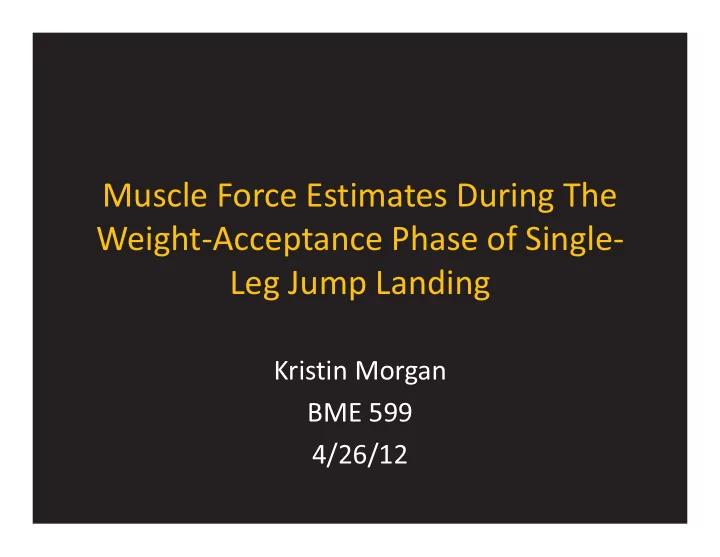

Muscle Force Estimates During The Weight-Acceptance Phase of Single- Leg Jump Landing Kristin Morgan BME 599 4/26/12
Motivation • Over 200,000 anterior cruciate ligament (ACL) injuries • $1.5 billion annually • 78% are non-contact injury • 22% result from jump landing
Background Role of the Anterior Cruciate Ligament (ACL) • One of four ligaments in the knee (ACL, PCL, MCL, LCL) • Restricts anterior translation of the tibia • Limits rotational movement http://www.aidmyknee.com/anterior-cruciate-ligament.php • Stabilizer
Background Characteristics of ACL Injury • Small Knee Flexion Angle • Elevated Knee Valgus Moment • Anterior Translation of the Tibia http://www.youcanbefit.com/ACL.html
Research Question • Kinematics • Kinetics • Surface electromyography (sEMG) • Muscles support the knee http://www.emg-eeg.com/emg/rutin-emg and could potentially reduce ACL injury risk What are the individual muscle force contributions to single-leg jump landing?
Experimental Design 2 1 3 58 participants conducted a • SLJL procedure – Jumped & Landed with preferred leg – Ball was perturbed during flight phase 6 5 4 Whole body kinematics & • GRF were measured sEMG collected for six • muscles 9 7 8 10 participant trials were • randomly chosen for further analysis
Experimental Design
Weight Acceptance Phase 6 5 4 3 2 1 0 Series of images for a subject-specific simulation during the weight acceptance of single-leg jump landing using a musculoskeletal model.
3D Musculoskeletal Model q 8 q 6 q 7 92 muscle-tendon actuators • q 11 q 5 q 9 q 3 q 10 q 4 23 degrees of freedom • Scaled to patient data • q 12 q 2 2 male Australian football players Height: 1.89m Mass: 86kg q 1 q 13 Delp et al. (1990, 2007), IEEE Trans Biomed Eng
Create Subject-Specific Simulation Scaling • Generic musculoskeletal model was scaled to subjects’ mass properties and segment dimensions obtained from experimental exams and marker data Inverse Kinematics (IK) • Derive joint angles from the experimental kinematic data Residual Reduction Analysis (RRA) • Create dynamically consistent simulations with the experimentally recorded ground reaction forces Computed Muscle Control (CMC) • Used to estimate muscle excitations and muscle forces
Computed Muscle Control
Computed Muscle Control Results
Computed Muscle Control Files Actuator Control Constraints Task Weightings
Computed Muscle Control Results
Validation Check Evaluate IK and CMC Kinematics Inverse Kinematics CMC Kinematics 60 Knee Flexion (°) 30 1.4 1.44 1.48 Time (s)
Validation Check Analyze CMC Residuals
Validation Check Compare sEMG and CMC Excitations
Computed Muscle Control Results
Computed Muscle Control Results
Discussion Largest muscle force estimates in • decreasing order were the quadriceps and gastrocnemius followed by the hamstrings Primary motor control task during • landing of producing a support moment capable of maintaining the center of mass in an upright position The gastrocnemius plays a much • larger role than the hamstrings muscles in dynamic knee movements during single-leg landing. Further analysis is necessary to • determine whether muscles may be selectively recruited based on moment arms to support the knee from externally valgus knee loading.
Future Work Additional Subjects Induced Acceleration
Recommend
More recommend